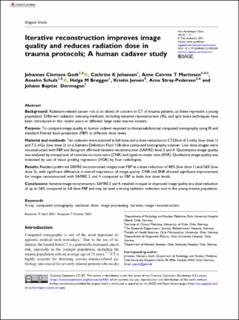| dc.contributor.author | Godt, Johannes Jakob Clemens | |
| dc.contributor.author | Johansen, Cathrine K. | |
| dc.contributor.author | Martinsen, Anne Catrine Trægde | |
| dc.contributor.author | Schulz, Anselm | |
| dc.contributor.author | Brøgger, Helga Maria | |
| dc.contributor.author | Jensen, Kristin | |
| dc.contributor.author | Stray-Pedersen, Arne | |
| dc.contributor.author | Dormagen, Johann Baptist | |
| dc.date.accessioned | 2022-02-23T12:03:15Z | |
| dc.date.available | 2022-02-23T12:03:15Z | |
| dc.date.created | 2021-12-30T16:15:36Z | |
| dc.date.issued | 2021-11-18 | |
| dc.identifier.citation | Acta Radiologica Open. 2021, 10 (10), 1-11. | en_US |
| dc.identifier.issn | 2058-4601 | |
| dc.identifier.uri | https://hdl.handle.net/11250/2980999 | |
| dc.description.abstract | Background: Radiation-related cancer risk is an object of concern in CT of trauma patients, as these represent a young population. Different radiation reducing methods, including iterative reconstruction (IR), and spilt bolus techniques have been introduced in the recent years in different large scale trauma centers.
Purpose: To compare image quality in human cadaver exposed to thoracoabdominal computed tomography using IR and standard filtered back-projection (FBP) at different dose levels.
Material and methods: Ten cadavers were scanned at full dose and a dose reduction in CTDIvol of 5 mGy (low dose 1) and 7.5 mGy (low dose 2) on a Siemens Definition Flash 128-slice computed tomography scanner. Low dose images were reconstructed with FBP and Sinogram affirmed iterative reconstruction (SAFIRE) level 2 and 4. Quantitative image quality was analyzed by comparison of contrast-to-noise ratio (CNR) and signal-to-noise ratio (SNR). Qualitative image quality was evaluated by use of visual grading regression (VGR) by four radiologists.
Results: Readers preferred SAFIRE reconstructed images over FBP at a dose reduction of 40% (low dose 1) and 56% (low dose 2), with significant difference in overall impression of image quality. CNR and SNR showed significant improvement for images reconstructed with SAFIRE 2 and 4 compared to FBP at both low dose levels.
Conclusions: Iterative image reconstruction, SAFIRE 2 and 4, resulted in equal or improved image quality at a dose reduction of up to 56% compared to full dose FBP and may be used a strong radiation reduction tool in the young trauma population. | en_US |
| dc.language.iso | eng | en_US |
| dc.publisher | SAGE Publications | en_US |
| dc.relation.ispartofseries | Acta Radiologica Open;Volume: 10, issue: 10 | |
| dc.rights | Navngivelse 4.0 Internasjonal | * |
| dc.rights.uri | http://creativecommons.org/licenses/by/4.0/deed.no | * |
| dc.subject | X-rays | en_US |
| dc.subject | Computed tomography | en_US |
| dc.subject | Radiation doses | en_US |
| dc.subject | Image processing | en_US |
| dc.subject | Iterative image reconstruction | en_US |
| dc.title | Iterative reconstruction improves image quality and reduces radiation dose in trauma protocols; A human cadaver study | en_US |
| dc.type | Peer reviewed | en_US |
| dc.type | Journal article | en_US |
| dc.description.version | publishedVersion | en_US |
| dc.rights.holder | © The Author(s) 2021 | en_US |
| cristin.ispublished | true | |
| cristin.fulltext | original | |
| cristin.qualitycode | 1 | |
| dc.identifier.doi | https://doi.org/10.1177/20584601211055389 | |
| dc.identifier.cristin | 1973038 | |
| dc.source.journal | Acta Radiologica Open | en_US |
| dc.source.volume | 10 | en_US |
| dc.source.issue | 10 | en_US |
| dc.source.pagenumber | 1-11 | en_US |

